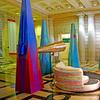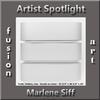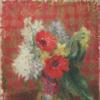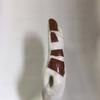Frank Bowling: Recent Paintings
- NEW YORK, New York
- /
- March 28, 2012
Spanierman Modern is pleased to announce the opening on March 29, 2012 of Frank Bowling: Recent Paintings, presenting twenty-four richly textured canvases in the abstract expressionist and color field mode by Bowling, whose vibrant, color-filled paintings earned him a place in 2005 as the first black Royal Academician. The exhibition is accompanied by a sixteen-page catalogue (available for $20 ppd) with an essay by artist, writer, and curator Carl E. Hazlewood and color illustrations of twelve works.
Frank Bowling was born in British Guyana, studied in London, lived for ten years in New York, and now divides his time between the two cities. Honored in 2008 with the Order of the British Empire (O.B.E.) for his service to art, Bowling has an international standing for his dedication to the modernist tradition. In the 1960s, he was at the forefront of a new generation of British artists. Among his classmates at the Royal College of Art, London, were David Hockney, R. B. Kitaj, Allen Jones, and Derek Boshier. On graduating in 1962 Frank Bowling won a silver medal to Hockney’s gold, but departing stylistically from his contemporaries who moved in the direction of Pop Art, Bowling found a basis for his work in the legacy of Jackson Pollock and Mark Rothko, while drawing on the influence of Francis Bacon. For his paintings, noted for their optical and surface complexities, Bowling uses a method that involves dripping and pouring paint until forms occur that express intense experiences of landscape and emotion. Often stitching and adhering fragments and strips from earlier painted pieces onto larger canvases, he summons the memory of his mother, a seamstress who parlayed her talent at sewing dresses, hats, and Indian saris into a successful business. As a teenager, Bowling worked a route for his mother, taking orders for clothing and selling swatches and pattern books. In works such as Tracey’sbouquet (At Swim Two Birds) (2011), created for an artist who once sent Bowling a bouquet of flowers, a bordering of delicate painted lace along with a stitched edge represents Bowling’s open-ended approach to painting. Such unusually articulated surfaces are present in other works as well.
Canvases such as The Waters of Speech (2011) reveal a subtle new richness of effect and color, demonstrating evidence of an imagination seeking a visual high watermark within its own formal terms. A pair of almost square paintings about six feet high, Wadi√one and Wadi√two (both 2011) include collaged canvas rectangles tipped toward each other. A rain of poured hues move down their centers, threatening to unhinge their color/spaces, yet holding close to the surface by the skin of casual yet precisely tuned tones in their “backgrounds.” In these works, Frank Bowling conjures an informal balancing act, while the structures of the works are fairly determined by their underlying geometry—not surprising for Bowling, who once made visual improvisations based on Fibonacci sequences and whose graduate thesis was on Mondrian. In many of the images, the light is peculiar and personal. Paintings like Mauveblaise, Eye & Ball Blaise, Hansel’shaus, and Madambutterfly tend to revolve around a daring green/violet axis of secondaries grounded in reds with deep rich dark tones of hard-to-describe color combinations. The shapes of some paintings—tall and relatively narrow—often recall classic pieces from the 1970s but with much more coloristic daring and visual games to play.
Frank Bowling’s new paintings prove that his ongoing modernist enterprise has continued to develop in relation to his own aims, demonstrating that he has found a way to make a disciplined and consistent contribution to a particular stream of painterly abstraction, which remains vital and productive in his hands.
Frank Bowling’s art is featured in several current and upcoming individual and group exhibitions. The solo shows consist of Frank Bowling: Poured Paintings, opening at Tate Britain on April 30, Frank Bowling: Recent Large Works, opening at Hales Gallery, London, on May 31, and Frank Bowling: Recent Small Works, opening at Chris Dyson Gallery, London, on July 6. A two-man show of the work of Bowling and Dennis DeCaires opened February 28 at the University of Glyndwr, in Wrexham, North Wales. Bowling is at the center of one the group exhibitions: Bowling's Friends, opening at the Cello Factory, London, on May 23. This show situates Bowling among artists of a younger generation whose work he admires. The other group shows include Migrations, which opened January 31 at Tate Britain (this show explores the theme of migration from 1500 to the present, reflecting the range of the Tate Britain's collections); British Design, 1948-2012: Innovation in the Modern Age, opening at the Victoria and Albert Museum on March 31; and A Family Affair, opening at the Cello Factory on June 2. On October 12, 2012, during Bowling's exhibition at the Tate Britain, the culture critic, writer, and curator of Bowling’s show at the Tate Britain, Courtney Martin will conduct a public conversation with the artist. This will take place during Frieze week and will be held in the Clore Auditorium from noon to 1:30 pm.
Bowling’s work is represented in major public collections around the world including the Victoria and Albert Museum, London; the Walker Art Gallery, Liverpool, England; Lloyds of London; the Metropolitan Museum of Art, New York; the Museum of Modern Art, New York; the Whitney Museum, New York; the Menil Foundation, Houston, Texas; the New Jersey State Museum, Trenton; the Currier Museum of Art, Manchester, New Hampshire; the Phillips Museum of Art, Franklin & Marshall College, Lancaster, Pennsylvania; Guyana National Collection, Castellani House, Georgetown; the John Simon Guggenheim Memorial Foundation, New York; the Museum of Fine Arts, Boston; the Kresge Art Center, Michigan State University, East Lansing; the Neuberger Museum, State University of New York, Purchase; Rhode Island School of Design, Providence; Royal College of Art, London; University of Liverpool; University of Delaware; Royal Academy of Arts, London; and the National Gallery of Jamaica, Kingston, West Indies.
Contact:
Martha CampbellSpanierman Modern
212-832-1400
mcampbell@spanierman.com
53 East 58th Street
New York, New York
inquiry@spaniermanmodern.com
212-832-1400
http://www.spaniermanmodern.com
About Spanierman Modern
Spanierman Modern specializes in modern and contemporary artists from the mid twentieth century to the present. Please see our artists represented.




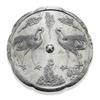

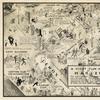

![Offering a Truce [Bested], 1895, is estimated to sell for between $1,300,000 and $1,800,000 on March 22, 2014, for The Russell: An Exhibition and Sale to Benefit the C.M. Russell Museum. Offering a Truce [Bested], 1895, is estimated to sell for between $1,300,000 and $1,800,000 on March 22, 2014, for The Russell: An Exhibition and Sale to Benefit the C.M. Russell Museum.](/images/c/a8/20/Dec10_Offering_a_Truce__Bested_300dpi100x100_c.jpg)
